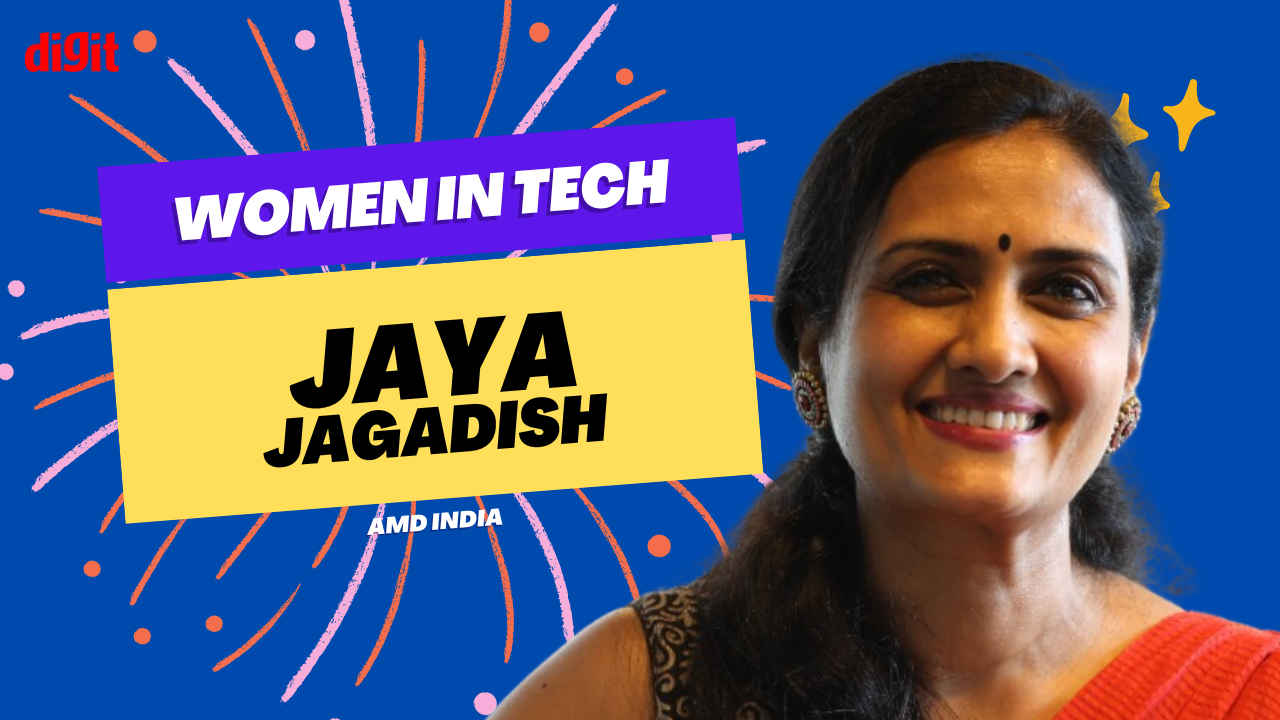Women’s Day 2024: AMD India’s Jaya Jagadish on empowering women in silicon design

Helming AMD India, Jaya Jagadish’s story isn’t just one of personal triumph but a roadmap for aspiring women leaders. “Women should embrace opportunities without overthinking or questioning one’s capabilities,” she states, highlighting the crucial lesson of overcoming the paralysis of self-doubt. Her advice underscores a proactive approach to career and life, advocating for a balance that does not overly favour one over the other.
 Survey
SurveyMy interview with Jaya Jagadish, the Country Head of AMD India and Senior Vice President of Silicon Design Engineering, couldn’t have come at a better time. As we celebrate International Women’s Day 2024, Jaya’s journey from a design engineer to a leadership titan in the male-dominated silicon design sector is inspiring to say the least. In this detailed exploration, we delve into her reflections, innovations under her leadership, challenges in the industry, and her aspirations for women breaking barriers not just at AMD India but everywhere. Edited excerpts from the interview follow:

Q) You have had an incredible professional journey. What are three valuable lessons that you would like to share with aspiring women leaders?
I would say that we need to approach challenges with an open mind and a can-do attitude. Women should embrace opportunities without overthinking or questioning one’s capabilities. It is essential that you overcome self-doubt and seize the moment, because often the window of opportunity is small.
Secondly, while work-life balance is crucial for everyone, women often tend to worry excessively about it. Recognize that your career is an integral part of your life, as is your family. It is possible to manage the demands of these two roles. Today we have many role models across industries who candidly share how they have navigated the two roles successfully.
Also read: Women’s Day 2024: HP India’s Ipsita Dasgupta on Women in Tech, AI and Gaming frontiers
Lastly, cultivate a solution mindset. When faced with challenges, focus on presenting solutions rather than dwelling on problems. This proactive approach not only contributes to problem-solving but also shapes how you are perceived as a leader.
Q) Under your leadership, AMD India has played a critical role in AMD’s CPU roadmap. What would you recall as some of the significant innovations that your team contributed to?
I started at AMD in 2005 as one of the first team members of AMD India’s development centre in Bangalore. In those early years, building and steering a CPU team in India involved fundamental challenges. There was a lot of scepticism around the skill set available in the country to undertake complex CPU designs. I and my team approached the challenge with a solution mindset. As experienced CPU design engineers were limited, we decided to hire fresh engineering graduates with an aptitude to learn and problem-solve. We invested time and resources to train them and in a short span they started working on important projects. For example, my team in India is responsible for building the CPU variants of the main core by adjusting memory, power configurations, adding various IPs etc. to cater to diverse industry applications.
Q) What would you say are two challenges in silicon design that you encountered and how did you navigate them?
Chip design is complex, and the complexity is increasing as transistor size shrinks placing a heightened emphasis on the verification process. The intricate designs today require a multifaceted verification approach involving step-by-step validation. We start with the verification of small blocks and then progressively expand to encompass the entire design.
To complicate matters further, the number of gates are growing, and this places constraints on fitting the entire design onto an emulator. While known bugs can be addressed easily, it’s challenging to identify and rectify unforeseen corner case bugs that may surface post tape-out. To tackle this, we coach our teams to be highly rigorous and give training on microarchitectures.
Also read: Women’s Day 2024: Cadence’s Kripa Venkatachalam on Women in Tech
The other challenge when it comes to chip design is the physical design. When I started my career almost 25 years ago, we were handling micron size designs. Today we are looking at nanometer designs. The closure of these designs again requires experience, extra scrutiny, planning, and diligent execution.
Q) What would you say is needed to encourage more women to take up silicon design?
I strongly believe we need more and more women role models in the industry. It was certainly missing when I was a young engineer myself. I used to wonder why there are so few women in this industry. Questions like, “Are women unable to cope with the demands?” and “Is it too difficult?” constantly crossed my mind. I would urge more women who have taken up this career to come out and share what excites them about this career.
Chip design is complex but there lies the opportunity to work on remarkable technology that is changing the world. What you need is passion and a willingness to learn. My advice to women engineers is to develop that inner conviction that you are as good as any other person in a leadership role in this industry.
Q) Is the industry doing anything to bring more women into this sector?
A lot of discussions are going on at industry, academia, and government level about increasing women’s participation in the semiconductor industry. I believe one approach is to address the issue at the grassroots by encouraging more girls to take up STEM studies and evangelise the semiconductor industry as a career option in colleges.
Secondly, we need to build more awareness within the corporations to plug attrition at mid-career. Many women drop out when they go through life cycle changes like parenthood. Once that break happens, most of them tend to not come back. Returnship programs that help in getting women back to work after a long break is one solution. We should also look at creating workplace flexibility to allow them to manage domestic responsibilities when they return to work post maternity.

Q) What was your focus as the Chairperson of the Semicon Talent Building Committee under the India Semiconductor Mission?
I steered the talent committee that was set up by the government to map and recommend ways to strengthen the semiconductor talent ecosystem in India. The recommendations made by the committee are in the implementation stage now. For example, we had proposed curriculum changes and AICTE is already making them in 300-plus engineering colleges that offer a major in VLSI design. I am now part of a talent building task force set up by the CII. We are focusing on developing advanced semiconductor related courses in partnership with universities including Purdue for people who want to upskill or reskill themselves.
Q) Can you share 2-3 initiatives that are being driven under your leadership to drive diversity and inclusion at AMD India?
At AMD India, we run a lot of initiatives to cultivate a culture of innovation and inclusivity. A recent one is the Women in Leadership program, for which I serve as the executive sponsor. The objective is to inspire and support women throughout their leadership journey, by providing the necessary guidance and resources needed to help them become effective leaders. Additionally, I provide one-on-one mentorship to high-potential women within AMD. I focus on empowering them to realise their full potential within the organisation.
Q) How do you see the future of the semiconductor ecosystem evolving in India, and what role do you envision for women in shaping this future?
The future of the semiconductor ecosystem in India is very promising. We have two significant advantages – access to a vast pool of raw talent that can be skilled and prepared, and highly conducive government policies. India is attracting substantial investments. Design was already a well-established domain. We boast the presence of design centres of every major semiconductor.
To answer the second part of the question, India’s population is about 50% women. Growth in any sector will not be possible if we do not diversify and utilise 50% of our talent and their skill sets. Women will play a significant role in meeting the current workforce demand of the semiconductor industry in India.
Q) How do you ensure the balance between cutting-edge development and ethical practices, particularly in terms of sustainability and responsible engineering?
It is not a choice; it is not an either or. Both are absolutely required. In a rapidly evolving industry such as ours, staying ahead of the curve and maintaining our competitive edge requires innovative approaches. However, ethics is non-negotiable. Every action taken by a corporation must adhere to ethical standards.
Q) As we celebrate Women’s Day, what message do you wish to share with both women and men in the semiconductor industry to foster a more inclusive and equitable working environment?
For women, I will re-emphasize the importance of adopting a long-term mindset and remaining steadfast in the pursuit of their career goals. In addition, as organisation’s we should foster a culture where gender diversity and equity are seen as quintessential for the growth of the company. A diverse environment fosters innovation and the exchange of ideas.
I will add that men should also strive to become more aware of unconscious biases that may exist. This requires education, and self-awareness because sometimes societal norms and practices get ingrained without us realising it.
Jayesh Shinde
Executive Editor at Digit. Technology journalist since Jan 2008, with stints at Indiatimes.com and PCWorld.in. Enthusiastic dad, reluctant traveler, weekend gamer, LOTR nerd, pseudo bon vivant. View Full Profile